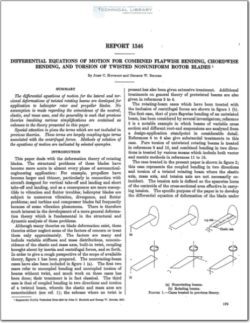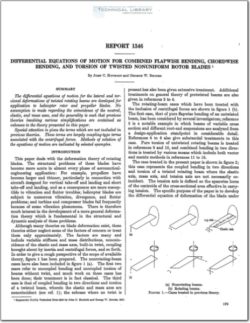NACA-Report-1346

- Version
- 233 Downloads
- 1.49 MB File Size
- 1 File Count
- December 4, 2015 Create Date
- December 4, 2015 Last Updated
National Advisory Committee for Aeronautics, Report - Differential Equations of Motion for combined Flapwise Bending, Chordwise Bending and Torsion of Twisted Non Uniform Rotor Blades

The differential equations of motion for the lateral and tar-
sional deformations of twisted rotating beams are developed for
application to helicopter rotor and propeller blades. No
assumption is made regarding the coincidence of the neutral,
elastic, and mass axes, and the generality is such that previous
theories involving carious simplifications are contained as
subcases to the theory presented in this paper.
Special attention is given the terms which are not included in
previous theories. These terms are largely coupling—type terms
associated with the centrifugal forces. Methods of solution of
the equations of motion are indicated by selected examples.
This paper deals with the defamation theory Of rotating
blades. The structural problems Of these blades have
become more acute in almost every phase of aeronautical—
engineering application: For example, propellers have
become larger and thinner, particularly in connection with
aircraft designed for vertical take-Off and landing and short
take-off and landing, and as a consequence are more suscep-
tible to vibration and flutter troubles; helicopter blades are
subject to numerous vibration, divergence, and flutter
problems; and turbine and compressor blades fail frequently
because of some vibration phenomena. There is therefore
much interest in the development of a more general deforma-
tion theory which is fundamental in the structural and
dynamic analysis of these problems.
Although many theories on blade deformation exist, these
theories either neglect some of the factors of concern or treat
them only approximately. The factors are many and
include variable stiffness and mass distributions, noncoin—
cidence Of the elastic and mass axes, built-in twist, coupling
brought about by inertia and centrifugal forces, and so forth.
In order to give a rough perspective of the scope of available
theory, figure 1 has been prepared. The nonrotating—beam
cases have also been included in figure 1 (a). The first two
cases refer to uncoupled bending and uncoupled torsion of
beams without twist, and much work on these cases has
been done; their treatment is in fact classical.
| File | Action |
|---|---|
| naca-report-1346.pdf | Download |

Comment On This Post